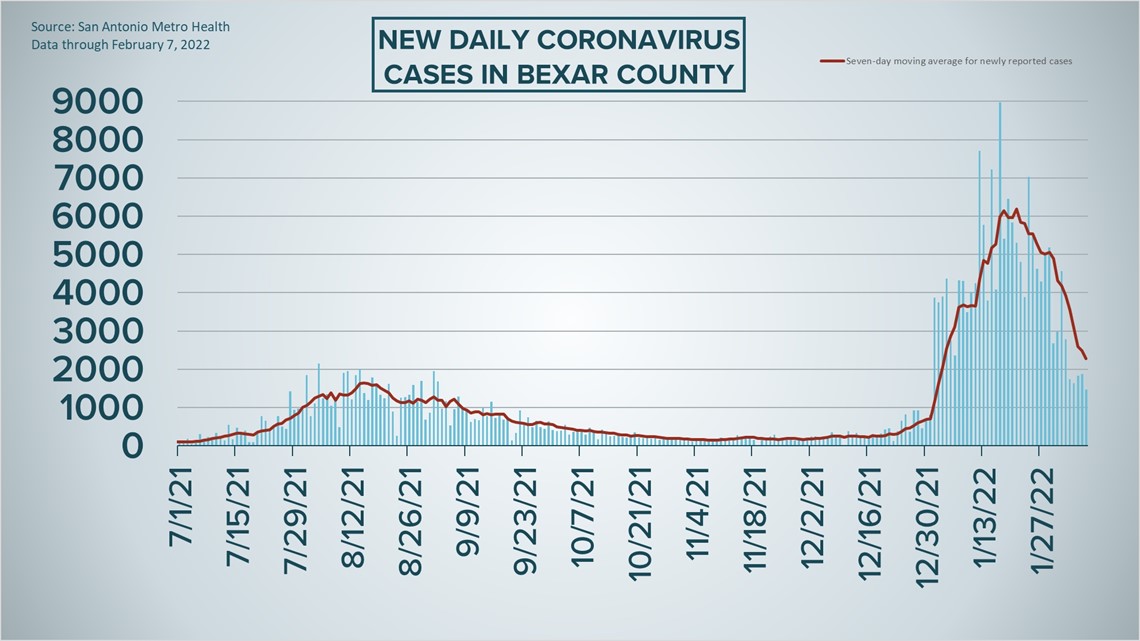SAN ANTONIO — Bexar County health authorities reported a fifth straight day of fewer than 2,000 new COVID-19 diagnoses on Monday, indicating that the surge of cases which led to skyrocketing pandemic totals to start 2022 may have begun to subside.
Metro Health tallied 1,475 new cases to start the week, after totals of 1,827 and 1,878 were reported on Saturday and Sunday, respectively. As a result, the seven-day moving average of new cases has fallen to 2,273, the lowest that number has been since Jan. 3.
More than 509,000 Bexar County residents have been diagnosed with the virus since the pandemic began.
Meanwhile, hospitalizations are also trending down. Sunday was the first time since mid-January that local patients receiving treatment for COVID-19 dropped below 1,000, and the figure stood at 969 on Monday. That's 227 fewer patients than a week ago, amounting to a 19% decrease.
Of those 969 patients, 239 are in intensive care and 107 are using ventilators to help them breathe.
While case numbers are trending down, Monday was also the worst day in several months for COVID-19 deaths, with 24 additional fatalities from virus complications reported Monday. At least, 5,159 San Antonio-area residents have died from coronavirus complications.
Masks are still available at some local pharmacies, as part of the federal government's effort to provide millions of them for free as the pandemic lingers on. Learn more here about where to find them in San Antonio.
How Bexar County is trending




Vaccine Progress in Bexar County
The following numbers are provided by San Antonio Metro Health. A full breakdown can be found here.
- 1.732 million eligible Bexar County residents have received at least one dose of the coronavirus vaccine as of Thursday, Feb. 3.
- 1.406 million eligible Bexar County residents are fully vaccinated as of Thursday, Feb. 3.
The CDC states that "when a high percentage of the community is immune to a disease (through vaccination and/or prior illness)," that community will have reached herd immunity, "making the spread of this disease from person to person unlikely."
The City of San Antonio breaks down the vaccination rates by zip code on Metro Health's Vaccination Statistics page.
Coronavirus in Texas
The total number of coronavirus cases in the state since the pandemic began grew by 14,295 on Monday, according to the Texas Department of State Health Services. That total includes 12,331 new confirmed cases and 1,964 new probable cases. More details can be found on this page.
Monday's figures bring the total number of Texans diagnosed with COVID-19 to more than 6.383 million.
An additional 17 Texans have died from virus complications, meanwhile, raising the statewide death toll to 79,429.
Coronavirus symptoms
The symptoms of coronavirus can be similar to the flu or a bad cold. Symptoms include fever or chills, cough, shortness of breath or difficulty breathing, fatigue, muscle or body aches, headache, new loss of taste or smell sore throat, congestion or runny nose, nausea or vomiting, and diarrhea, according to the Centers for Disease Control.
Most healthy people will have mild symptoms. A study of more than 72,000 patients by the Centers for Disease Control in China showed 80 percent of the cases there were mild.
But infections can cause pneumonia, severe acute respiratory syndrome, kidney failure, and even death, according to the World Health Organization. Older people with underlying health conditions are most at risk.
Experts determined there was consistent evidence these conditions increase a person's risk, regardless of age:
- Chronic kidney disease
- COPD (chronic obstructive pulmonary disease)
- Obesity (BMI of 30 or higher)
- Immunocompromised state (weakened immune system) from solid organ transplant
- Serious heart conditions, such as heart failure, coronary artery disease, or cardiomyopathies
- Sickle cell disease
- Type 2 diabetes
- The CDC believes symptoms may appear anywhere from two to 14 days after being exposed.
Human coronaviruses are usually spread...
- Between people who are in close contact with one another (within about 6 feet).
- Through respiratory droplets produced when an infected person coughs, sneezes or talks. These droplets can land in the mouths or noses of people who are nearby or possibly be inhaled into the lungs.
- Some recent studies have suggested that COVID-19 may be spread by people who are not showing symptoms.
Help stop the spread of coronavirus
- Stay home when you are sick.
- Eat and sleep separately from your family members
- Use different utensils and dishes
- Cover your cough or sneeze with your arm, not your hand.
- If you use a tissue, throw it in the trash.
Find a Testing Location
City officials recommend getting a COVID-19 test if you experience fever or chills, cough, shortness of breath or difficulty breathing, fatigue, muscle or body aches, headache, new loss of taste or smell, sore throat, congestion or runny nose, nausea or vomiting, or diarrhea.
Here's a Testing Sites Locator to help you find the testing location closest to you in San Antonio.
Latest Coronavirus Headlines
- 'We failed on the social science': US reaches 900,000 COVID-19 deaths
- Coronavirus Tracker: Bexar County surpasses 500,000 total cases
- No, a scientific study doesn't say you can smoke marijuana to prevent COVID-19
- Sweden is the latest European country to end COVID restrictions
- Yes, the CDC changed its definition of vaccine to be ‘more transparent’
- Mother caught COVID during pregnancy and lost her son. Now, she needs you to hear her story.
- CVS, Walgreens, Walmart, H-E-B provide updates on when you can get your free N95 masks

